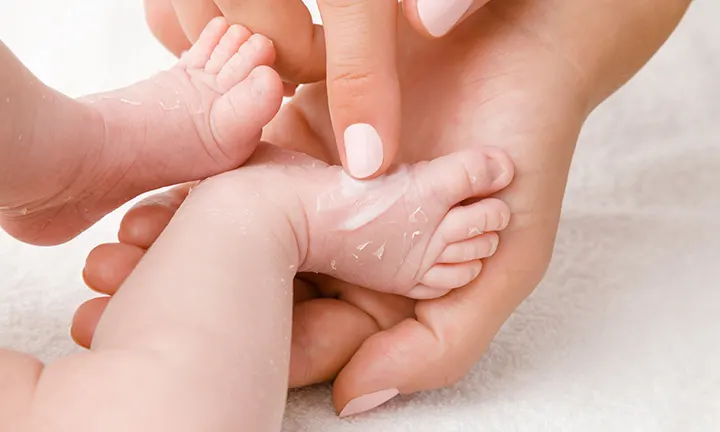Dry, Peeling Skin in Newborns and Older Babies
You may notice some flaking or peeling on your newborn’s skin in the first few days or weeks after delivery. And your older baby’s skin may also become dry and even peel from time to time. Read on to find out what causes your little one's dry, flaky, or peeling skin, and pick up 13 ideas on how you can help prevent your baby’s skin from drying out.
Why Newborns and Older Babies Have Peeling Skin
A newborn’s skin is delicate, especially right after birth, and it's likely that your infant’s skin may be peeling. Flaky or peeling skin is normal at this stage and doesn’t require any special treatment. Basically, in your newborn’s first few days and weeks, the top layer of skin sheds. This skin peeling tends to be more common for babies who were born past their due date. It’s not just during the early newborn phase that you may notice peeling skin. Children’s skin is typically thinner and more delicate than adult skin, and this means that it can lose moisture faster and dry out more quickly. Therefore, don’t be surprised if, at some point, you see dryness, flaking, or peeling skin on your older baby or toddler.
If your baby has a skin condition like atopic dermatitis (a form of eczema), you may also notice more frequent dryness, flaking, or peeling.
13 Ways to Manage Your Baby’s Dry, Peeling Skin
These are some steps you can take to protect your baby’s delicate skin and help prevent dryness and peeling:
Leave the vernix on. Some babies are born covered in a whitish waxy coating called vernix , a substance that helps prevent your newborn baby’s skin from drying out. Rather than wiping or washing this off immediately after birth, experts recommend leaving it on for a while longer to help keep the skin moist. Vernix acts as a natural moisturizer and may even have antibacterial properties.
Wait on your newborn baby’s first bath. Postpone bathing your newborn in a tub or the sink until the umbilical cord stump has fallen off, which typically happens a week or two after birth. In the meantime, you can give your baby sponge baths.
Cut down on the number of baths. Newborns don’t get that dirty, so they don’t need to be bathed that often. Three baths a week during your baby’s first year is probably enough.
Keep baths short. It’s better to give your baby short baths of about 10 minutes rather than long soaks that can dry the skin.
Avoid hot water during bath time. Water that’s too hot can irritate your baby’s sensitive skin and lead to dryness and itching; it can also lead to accidental scalds or burns. Instead, keep the water lukewarm. Check the temperature before placing your baby in the water by testing it with your elbow or inner wrist. Get more baby bath time tips here.
Avoid harsh soaps and fragrant bubble baths. Many soaps and bath products contain harsh chemicals and fragrances that can irritate your baby’s delicate skin. So, it’s best to avoid any products that aren’t specially designed for babies. Instead, use a gentle cleanser, mild soap, or baby wash that’s hypoallergenic and free of fragrances.
Dry your baby’s skin carefully. Be careful not to rub your baby’s skin when drying them off. Instead, gently pat your baby dry. Rubbing can irritate their skin and strip the skin of naturally occurring protective oils.
Apply a moisturizer. Choose a moisturizer that’s made especially for babies, and apply it soon after your baby’s bath. Their skin will absorb the moisturizer more easily when it’s still a bit damp. You could also moisturize your baby’s skin in between baths. Simply mist their skin with a little water beforehand to help with absorption.
Use a non-irritating detergent. Laundry detergents that are labeled “free and clear” or “sensitive” don’t contain fragrances, dyes, or perfumes and are good choices for washing your baby’s clothes, towels, and bedding. Avoid dryer sheets and fabric softeners, as these contain oils, chemicals, and fragrances that can irritate your baby’s skin.
Choose soft, natural fabrics. Dress your baby in cotton clothing. Unlike some synthetics, cotton is breathable and won’t trap sweat, which can lead to irritation and even heat rash. Also, make sure that any other fabrics that come in contact with your baby, such as those found in sheets and swaddle blankets, are made of cotton or another natural material like bamboo.
Wash clothing and fabrics before using them. Make sure to wash all clothing, bedding, towels, and swaddle blankets before your baby uses them to ensure that any chemicals or dyes from the manufacturing process are washed away. A baby-safe laundry detergent is best.
Add humidity to your baby’s room. Indoor air can be extremely dry, especially in winter when humidity levels drop due to heating. Consider using a cool-mist humidifier in your baby’s room.
Keep your baby away from the sun. It’s important to keep young babies away from both direct and indirect sunlight, as their delicate skin can become sunburned and damaged very quickly. Whenever you’re outside with your baby, head for the shade, such as a spot under a tree or an umbrella, and use your stroller’s canopy. Dress your baby in lightweight cotton clothing that covers their arms and legs, and add a wide-brimmed hat.
When to Call Your Baby’s Healthcare Provider
After the first few weeks of the typical newborn skin peeling and flaking have passed, if your baby’s skin still seems dry or even irritated, even when you've followed all the tips above, it’s best to get in touch with your baby’s healthcare provider. Sometimes dry, flaky skin may be the result of an allergic reaction or skin rash that may need to be treated with prescription medication. If the red, flaky skin is in the diaper area, it may be a diaper rash. Diaper rash can often be managed at home with frequent diaper changes, exposing the skin to air more often, and by using a barrier ointment. Still, if the diaper rash looks severe or doesn’t go away, it’s worth contacting your baby’s provider for personalized advice on what to try next.
The Bottom Line
Seeing peeling skin on your newborn is nothing to be alarmed about. It’s completely normal and may continue for the first week or two as that top layer of skin slowly sheds.
After this initial period, however, your baby’s delicate and sensitive skin is still prone to drying out and peeling. To help prevent this, you can take steps such as shortening the length of bath time, using a moisturizer, avoiding synthetic fabrics, washing your baby’s clothes and bedding in a laundry detergent designed for babies, and even using a cool-mist humidifier.
If your baby’s skin continues to be dry or flaky, contact their healthcare provider. It may be a sign of a rash or an allergic reaction requiring medical treatment, such as a prescription ointment.
A little dryness aside, your baby’s skin is still irresistible, so keep on kissing those chubby cheeks, blowing raspberries on their tummy, and enjoying skin-to-skin contact.
How We Wrote This Article The information in this article is based on the expert advice found in trusted medical and government sources, such as the American Academy of Pediatrics and the American College of Obstetricians and Gynecologists. You can find a full list of sources used for this article below. The content on this page should not replace professional medical advice. Always consult medical professionals for full diagnosis and treatment.
Join a World of Support
through Pregnancy and Parenthood.
TRACK WITH TOOLS
LEARN WITH EXPERTS
GET REWARDED





